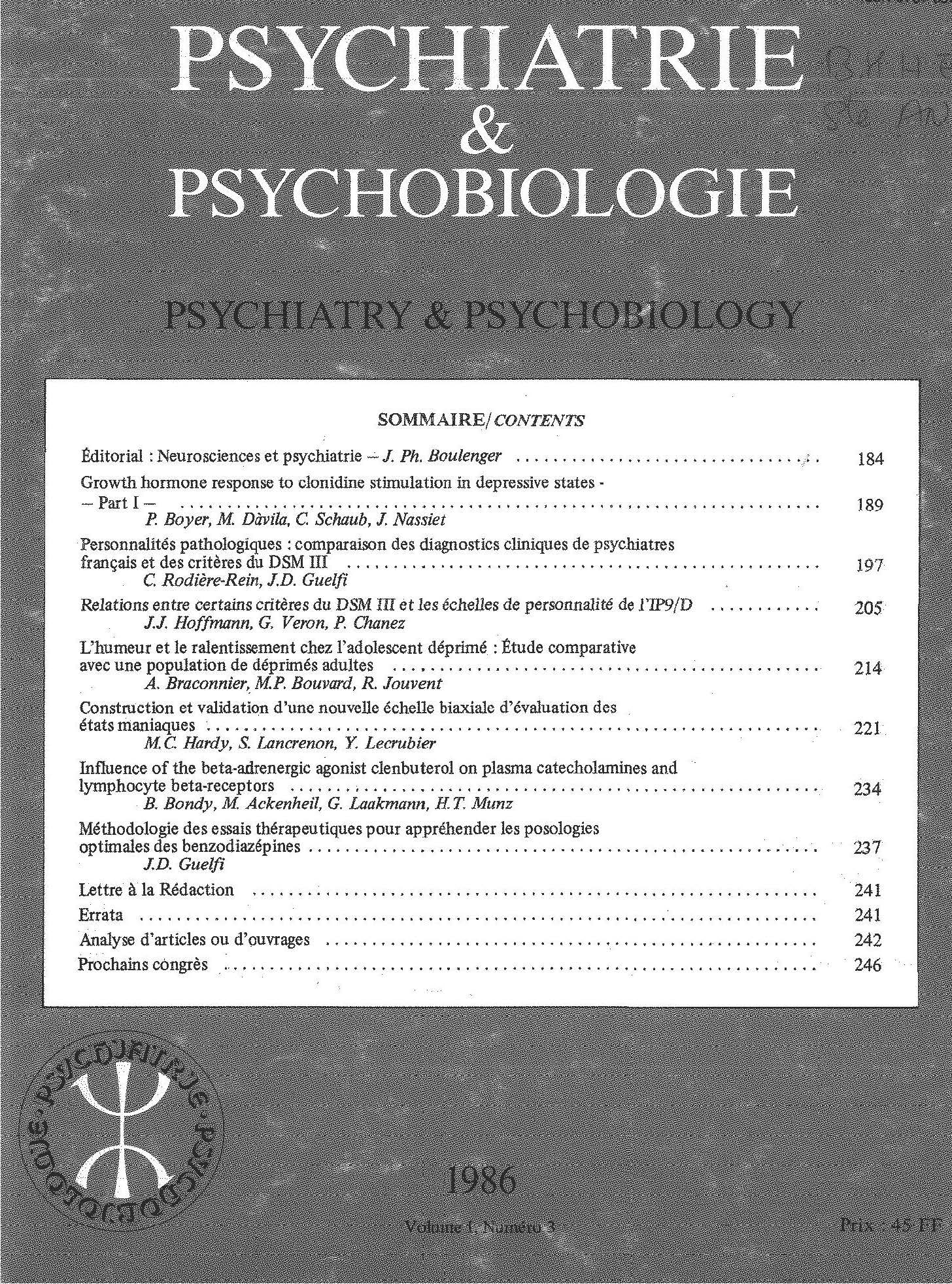Article contents
Etude comparative multicentrique en double aveugle de deux benzodiazépines chez 117 patients ambulatoires - alprazolam vs clobazam
Published online by Cambridge University Press: 28 April 2020
Résumé
L’alprazolam et le clobazam ont été comparés au cours d’une étude prospective randomisée en double aveugle d’une durée de quatre semaines, en stricte monothérapie à posologie ajustée en fonction de l’efficacité et de la tolérance du malade, chez 117 patients ambulatoires présentant un trouble névrotique anxieux selon les critères du DSM II, dont l’intensité était comprise entre 18 et 35 à l’échelle d’anxiété de Hamilton.
L’efficacité de l’alprazolam est significativement supérieure à celle du clobazam sur l’appréciation globale de l’efficacité selon le médecin (p = 0.04) et le malade (p = 0.03) sur l’un des symptômes-cibles (p = 0.02), sur la tolérance globale (p = 0.02), ainsi que sur le nombre d’effets secondaires (p = 0.05); il n’existe pas de différence significative entre les deux produits sur l’échelle de Hamilton ou sur la version abrégée à 24 items de l’échelle d’auto-évaluation B.A.T.E. (Bonis Anxiété Trait Etat). Les posologies journalières moyennes utilisées en fin d’essai ont été de 2.95 mg et 28.5 mg pour l’alprazolam et le clobazam respectivement.
Les résultats observés concernant l’efficacité et la tolérance des deux produits sont discutés en termes de comparabilité des groupes, de sous-catégories d’anxiété étudiées, de posologies utilisées, ainsi que des nuances observées selon qu’on raisonne en termes d’évaluation globale ou en termes d’échelles psychométriques.
Summary
A prospective randomized, double-blind trial has been conducted comparing alprazolam and clobazam administered in strict monotherapy for four weeks, using flexible dosage adjusted according to efficacy and side effects in 117 anxious outpatients.
To be included in the study, patients had to be aged from 18 to 65, present primary anxiety with anxiety symptoms present for a minimum of one month, have a total score of between 18 and 35 on the Hamilton Anxiety Rating Scale (HARS), and be free of any previous psychotropic medication for at least four days.
Although no significant difference was observed regarding the HARS or the abbreviated 24-item version of the B.A.T.E. (Bonis Anxiété Trait Etat) self rating scale (Appendix 1), the efficacy of alprazolam was judged significantly superior to that of clobazam regarding psychiatrists’ (p = .04) and patients’ (p = .02) average score for efficacy, one target symptom (p = .02), global evaluation of safety (p = .02) and number of side effects (p =.05) (see Tables 3, 6 and 7).
However, both groups did show dramatic improvement from baseline for the majority of efficacy measures. For example, on the HARS score, the alprazolam group went from a mean of 25.6 at the initial visit to a mean score of 9.7 at Week 4, while the clobazam group went from 25.6 to 11.0. At the end of the trial, mean dosage reached 2.95 mg for alprazolam (dose range 1.5 - 4.5 mg) and 28.5 mg for clobazam (dose range 10 - 40 mg) (see Table 9).
The most common side effects reported during the study were drowsiness, dizziness, and dry mouth in both groups, see Table 6.
In conclusion, both alprazolam and clobazam appeared to be effective in alleviating the symptoms of anxiety. However, significant differences between the two groups appeared in favour of alprazolam as regards a number of measures of efficacy and safety.
Such results need to be confirmed by currently used psychometric scales before being widely accepted.
Keywords
- Type
- Research Article
- Information
- Copyright
- Copyright © European Psychiatric Association 1987
References
- 1
- Cited by



Comments
No Comments have been published for this article.